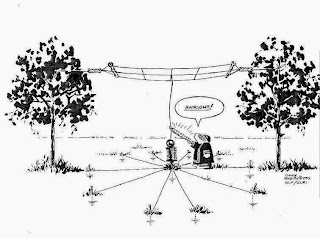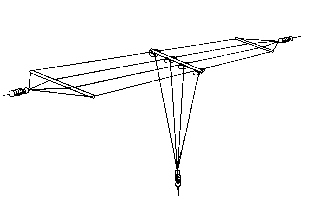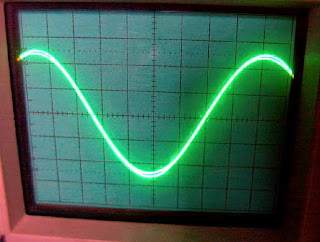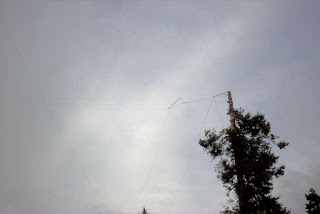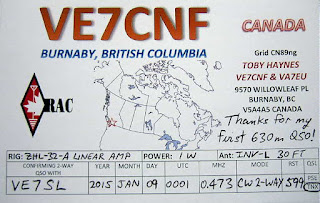Posts Tagged ‘LF’
 Conditions Rising
Conditions Rising
Conditions towards the east on LF as well as on the broadcast band (BCB) have taken a positive leap forward over the past few days. Last night, 160m was open to Europe from here, the first opening of the season as far as I am aware. I also spent some time listening to a dozen or more TA (Trans-Atlantic) carriers on the broadcast band, signalling good conditions over the pole finally.The polar skip also extended down into the LF band, as it did the previous night.
In the afternoon hours I started watching for Europe1 on 183kHz, transmitting from western Germany, and was able to see its weak carrier on the Perseus SDR's waterfall display several hours before sunset. Twilight here brought a dramatic improvement in signal strength as shown below.
As daylight approached the transmitter site in Germany, the 183kHz signal provided a good visual example of 'dawn-enhancement', with the signal showing a dramatic flare on the waterfall indicating its build-up in strength.
Once dawn arrived, it was interesting to see that the signal was able to hang-on for over an hour with reasonable strength before fading out rather quickly. Even though the transmitter site was in full daylight, the dark skies to the west were able to sustain propagation for some time before it all came crashing down.
Of late, the pre-dawn hours here have also been providing some exceptionally strong signals from Asia on the BCB. These are often enhanced at sunrise as well, as the strength often takes a short fast peak, before fading out for the day.
One of the loudest this week was from JOAK (NHK1) in Tokyo on 594 kHz ... listen ...
This was heard on the Perseus SDR and inverted-L antenna. The LF polar signals shown above, were recorded with the 10' X 20' loop and Wellbrook preamp while looping towards Europe at 030 degrees.
With the DST going positive, hopefully these good conditions will continue to build over the next few weeks. October is often one of the best months of the year for LF/MF DX.
In the afternoon hours I started watching for Europe1 on 183kHz, transmitting from western Germany, and was able to see its weak carrier on the Perseus SDR's waterfall display several hours before sunset. Twilight here brought a dramatic improvement in signal strength as shown below.
As daylight approached the transmitter site in Germany, the 183kHz signal provided a good visual example of 'dawn-enhancement', with the signal showing a dramatic flare on the waterfall indicating its build-up in strength.
Once dawn arrived, it was interesting to see that the signal was able to hang-on for over an hour with reasonable strength before fading out rather quickly. Even though the transmitter site was in full daylight, the dark skies to the west were able to sustain propagation for some time before it all came crashing down.
Of late, the pre-dawn hours here have also been providing some exceptionally strong signals from Asia on the BCB. These are often enhanced at sunrise as well, as the strength often takes a short fast peak, before fading out for the day.
One of the loudest this week was from JOAK (NHK1) in Tokyo on 594 kHz ... listen ...
This was heard on the Perseus SDR and inverted-L antenna. The LF polar signals shown above, were recorded with the 10' X 20' loop and Wellbrook preamp while looping towards Europe at 030 degrees.
With the DST going positive, hopefully these good conditions will continue to build over the next few weeks. October is often one of the best months of the year for LF/MF DX.
 |
| courtesy: http://wdc.kugi.kyoto-u.ac.jp/dst_realtime/presentmonth/index.html |
 LF/MF Moving Closer For U.S. Amateurs
LF/MF Moving Closer For U.S. Amateurs
With all commentary periods for the FCC's 'Notice of Proposed Rulemaking' (Docket 15-99) now closed, it appears that one of the last comments to be filed may contain the most powerful arguments in favor of swift implementation.
In its extremely detailed 42-paged submission, the ARRL states, in no uncertain terms, the reasons why access to both the 2200m LF band and the 630m MF band should not be held back and that service rules should be 'finalized'. Indeed the powerful arguments stated in favor of implementation should go a long way in making this happen sooner rather than later.
The FCC's position is that there is little to no evidence to indicate that amateur radio operation on either band would be incompatible with power company PLC systems, going as far as stating that at distances of 1km or more from PLC lines, "there is no chance of interference". Further supporting their claim, the thousands of hours of experimental operation were offered as powerful proof and that the ARRL was “unaware of any reports of interference to PLC systems arising from that operation conducted pursuant to numerous Part 5 experimental licenses…in the large band utilized by PLCs.”
In addition, the ARRL had harsh words regarding the FCC's attempt to legitimize the growing number of fish-net beacons in the 160m band, and pulled no punches regarding their position in this matter.
"There is no indication that these buoys are compatible with other uses in the band, no track record of interference avoidance or resolution, and certainly no indication that the current operators can be relied on for compliance with the Commission’s rules."
"The Commission is urged to avoid enacting rules that it has no effective ability or intention to enforce. That fishing vessels have, with impunity, illegally deployed radio buoys in this band on a widespread basis (whether or not due to misrepresentations of the importers and retailers of these devices or due to a disregard of the Commission’s rules generally) without even nominal enforcement actions by the Commission, provides no basis for assuming that there will be compliance with any deployment limitations (including geographic deployment restrictions) on these buoys going forward. Nor is there any basis for the assumption that there will be any enforcement action taken with respect to continued illegal operation of the buoys if and when interference is caused. Spectrum planning by the Commission in this context has to be based on ex ante determinations of compatibility rather than mere assumptions, especially where the record indicates such a low level of historical compliance."
A summary of the comments can be read here in the ARRL News while all comments filed for the NPRM be found here temporarily, while the FCC site is down for maintenance.
 Sparking-Up On 2200m
Sparking-Up On 2200m
I haven't been on 2200m (135.7 - 138.8 KHz) for some time ... my last transmissions on this band were almost three years ago. The recent acquisition of the 630m band has refocused a lot of my attention but Canadian activity has never been very high on the real 'top band'. Hopefully when the U.S. gets the 2200m band soon, activity will increase on both sides of the border.
An e-mail alert from Toby, VE7CNF, on the other side of Georgia Strait, indicated that everything was ready for a two-way test on 2200m and he was looking for his initial contact on the band. Having not been on the band for such a long time, some review of my 'tune-up' procedures were in order as well as the need to burn out the spider webs in my outdoor loading coil.
Since being on 2200m, I had modified my 2200m kilowatt transmitter so that it could also be used on the new 630m band. To change bands from 630m back to 2200m, I needed to swap the frequency-sensitive power divider back to 2200m as well as re-set the DDS frequency.
Setting my DDS to the correct control frequency and keying the driver stage revealed no sign of a signal on 137.779 KHz. This was puzzling and several re-checks turned-up no reason for the problem ... it seemed as if there was no signal from the DDS into the transmitter. I set everything back to 630m, just to confirm that there wasn't a more serious problem but everything worked just fine. It was then that I realized my error.
When modifying the transmitter, three years ago, I had also changed the transmitter's input frequency divider from a 'divide-by-four' to a 'divide-by-two' scheme. My original system on 137KHz started with a DDS frequency in the 5.48MHz range and then was divided by ten before being fed to the transmitter's input where the 548KHz signal was then divided by four. Using a higher DDS frequency allowed for greater frequency resolution at 2200m and allowed for very small frequency adjustments across the band. I would have kept the same system for 630m except that my 'divide-by-ten' chip was not very happy at 18MHz and refused to divide.The newer system now only allows me to move around the band in 4.5Hz steps. It's really not much of a problem as there is presently a minuscule amount of activity in Canada on 2200m, but as previously mentioned, this may change when U.S. amateurs gain access to the band.
Having sorted out my transmitter problems and confirming that all was well, the next task was to check antenna resonance and impedance matching as it would more than likely not be the same as I had left it. A low-power check using the 'scopematch' indicated that both resonance and impedance were not optimized. Tapping down on the loading coil by one-turn took care of resonance while adjusting the impedance tap in my matching transformer to its lowest value (see matching scheme below) resulted in a near perfect match on the scope.
I'm guessing that the resonance change was due to the recent heavy trimming of the 80' Balsam that supports one end of my 'inverted-L' and large three-wire flatop.
The tree's crown had previously been very dense and some of the branches were almost touching the flatop. The close proximity always made me worry about possible flashover at the antenna ends as voltages here would be several kilovolts. Removing much of the wet green tree branches directly beneath the flatop also likely contributed to the slight change in resonance.
The change in impedance to a lower value may have been due, in part, to the removal of the tree branches as well but more likely it was reflecting the change in my ground system. When I had last been on (in mid-winter), the ground was well saturated and the water table at normal heights. The present conditions are just the opposite as things are drier than they have ever been and the water table has certainly dropped substantially.
The sked with VE7CNF went smoothly and it was nice to see another new Canadian station taking an interest in the band, along with all of its challenges. Toby's 200W signal was a solid 559 here even with his small antenna system yet to be fully optimized. As well, he was bothered by heavy switching-power supply QRM from a nearby neighbour. Unfortunately, such noise sources seem to be increasing in numbers and are making operation on LF, already a big challenge, even more challenging. Toby has taken up the challenge with enthusiasm and has now had contacts on 2200m well as on 630m, adding to the ranks of active VE7's on LF and ... demonstrating yet again that amateurs can enjoy the LF bands with small 'backyard' antenna systems. Don't let living in the city be a reason to avoid our new LF bands.
Wouldn't it be great to see some activity from our neighbours in VE6 or VE5, both easily workable on both bands from the west coast... maybe you're up to the challenge!
An e-mail alert from Toby, VE7CNF, on the other side of Georgia Strait, indicated that everything was ready for a two-way test on 2200m and he was looking for his initial contact on the band. Having not been on the band for such a long time, some review of my 'tune-up' procedures were in order as well as the need to burn out the spider webs in my outdoor loading coil.
Since being on 2200m, I had modified my 2200m kilowatt transmitter so that it could also be used on the new 630m band. To change bands from 630m back to 2200m, I needed to swap the frequency-sensitive power divider back to 2200m as well as re-set the DDS frequency.
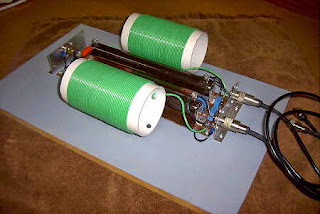 |
| 2200m Power Divider |
When modifying the transmitter, three years ago, I had also changed the transmitter's input frequency divider from a 'divide-by-four' to a 'divide-by-two' scheme. My original system on 137KHz started with a DDS frequency in the 5.48MHz range and then was divided by ten before being fed to the transmitter's input where the 548KHz signal was then divided by four. Using a higher DDS frequency allowed for greater frequency resolution at 2200m and allowed for very small frequency adjustments across the band. I would have kept the same system for 630m except that my 'divide-by-ten' chip was not very happy at 18MHz and refused to divide.The newer system now only allows me to move around the band in 4.5Hz steps. It's really not much of a problem as there is presently a minuscule amount of activity in Canada on 2200m, but as previously mentioned, this may change when U.S. amateurs gain access to the band.
Having sorted out my transmitter problems and confirming that all was well, the next task was to check antenna resonance and impedance matching as it would more than likely not be the same as I had left it. A low-power check using the 'scopematch' indicated that both resonance and impedance were not optimized. Tapping down on the loading coil by one-turn took care of resonance while adjusting the impedance tap in my matching transformer to its lowest value (see matching scheme below) resulted in a near perfect match on the scope.
I'm guessing that the resonance change was due to the recent heavy trimming of the 80' Balsam that supports one end of my 'inverted-L' and large three-wire flatop.
The tree's crown had previously been very dense and some of the branches were almost touching the flatop. The close proximity always made me worry about possible flashover at the antenna ends as voltages here would be several kilovolts. Removing much of the wet green tree branches directly beneath the flatop also likely contributed to the slight change in resonance.
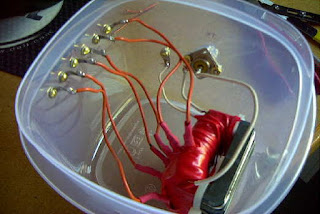 |
| Impedance Matching Transformer On TV Flyback Cores |
The sked with VE7CNF went smoothly and it was nice to see another new Canadian station taking an interest in the band, along with all of its challenges. Toby's 200W signal was a solid 559 here even with his small antenna system yet to be fully optimized. As well, he was bothered by heavy switching-power supply QRM from a nearby neighbour. Unfortunately, such noise sources seem to be increasing in numbers and are making operation on LF, already a big challenge, even more challenging. Toby has taken up the challenge with enthusiasm and has now had contacts on 2200m well as on 630m, adding to the ranks of active VE7's on LF and ... demonstrating yet again that amateurs can enjoy the LF bands with small 'backyard' antenna systems. Don't let living in the city be a reason to avoid our new LF bands.
Wouldn't it be great to see some activity from our neighbours in VE6 or VE5, both easily workable on both bands from the west coast... maybe you're up to the challenge!
 Canadian 630m Ops Meet
Canadian 630m Ops Meet
Yesterday I had the pleasure of meeting VA7MM (Mark) and VE7CNF (Toby) along with their respective XYL's May (VE7MAY) and Nancy. They have been spending the week cruising BC's Southern Gulf Islands and made a stop here on Mayne Island.
After a visit to the boat, a magnificent fractionally sloop-rigged 32' Beneteau, the Hakuna Matata, we all returned here to the house for refreshments, dinner and a station / antenna inspection. Part way through the visit I realized that our group contained 50% of Canada's active 630m operators, a rather sorry but true fact. In actuality, five out of the six Canadian 630m ops are VE7's! With such a special occurrence, a picture of the somewhat motley but enthusiastic crew was in order, with arms appropriately folded for the formal occasion.
Both Toby and Mark have plans for improving their 630m systems once the summer weather forces them back to the workbench and both look forward to more 630m operation this coming season ... Canada, the west-coast is waiting for you.
Canadian amateurs have been fortunate enough to gain operating privileges in this very interesting part of the spectrum (472-479KHz) where surprisingly good results can be had with small backyard antenna systems. Hopefully with more activity from the west coast, amateurs in the prairie provinces and further east ... especially in highly-populated VE3, will take more interest in the band as two-way communications between the provinces can readily be done during the quiet winter nights.
With the USA well on its way to getting 630m operating privileges as well, it would be nice to see more Canadians on the band to take advantage of what is bound to be a flurry of activity from our southern neighbours ... there are already a dozen or more experimental stations there, just waiting to make the switch when the word comes.
More information on 630m operating and equipment see three related blogs:
630m Resources - Part 1
630m Resources - Part 2
630m Resources - Part 3
For a listing of all 630m-related blogs, click here.
| Hakuna Matata under sail |
After a visit to the boat, a magnificent fractionally sloop-rigged 32' Beneteau, the Hakuna Matata, we all returned here to the house for refreshments, dinner and a station / antenna inspection. Part way through the visit I realized that our group contained 50% of Canada's active 630m operators, a rather sorry but true fact. In actuality, five out of the six Canadian 630m ops are VE7's! With such a special occurrence, a picture of the somewhat motley but enthusiastic crew was in order, with arms appropriately folded for the formal occasion.
 |
| Mark (VA7MM), myself and Toby (VE7CNF) |
Canadian amateurs have been fortunate enough to gain operating privileges in this very interesting part of the spectrum (472-479KHz) where surprisingly good results can be had with small backyard antenna systems. Hopefully with more activity from the west coast, amateurs in the prairie provinces and further east ... especially in highly-populated VE3, will take more interest in the band as two-way communications between the provinces can readily be done during the quiet winter nights.
With the USA well on its way to getting 630m operating privileges as well, it would be nice to see more Canadians on the band to take advantage of what is bound to be a flurry of activity from our southern neighbours ... there are already a dozen or more experimental stations there, just waiting to make the switch when the word comes.
More information on 630m operating and equipment see three related blogs:
630m Resources - Part 1
630m Resources - Part 2
630m Resources - Part 3
For a listing of all 630m-related blogs, click here.
 A More Optimistic Cycle 25
A More Optimistic Cycle 25
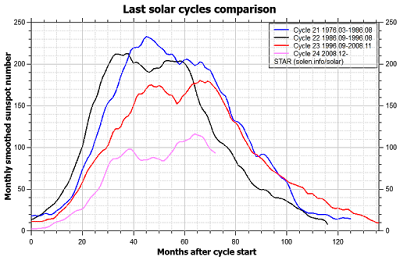 |
| courtesy: http://www.solen.info/solar/ |
With all of the doom and gloom forecasts for the upcoming solar cycles, I was reminded of the various prognostications that were made for our present Cycle 24. I recall one in particular, made in the winter of 2006 ...
Solar cycle 24, due to peak in 2010 or 2011 "looks like its going to be one of the most intense cycles since record-keeping began almost 400 years ago," says solar physicist David Hathaway of the Marshall Space Flight Center. He and colleague Robert Wilson presented this conclusion last week at the American Geophysical Union meeting in San Francisco.
So much for that prediction!
It seems that at least one group, led by Leif Svalgaard, got it right, as W4ZV recently reminded us on the Topband reflector ...
I had to do a memory refresh but finally recalled that Leif Svalgaard, et.al.
accurately predicted Cycle 24 in October 2004. He did not use conveyor
belt theory but polar field measurements:
"Using direct polar field measurements, now available for four solar
cycles, we predict that the approaching solar cycle 24 ( 2011 maximum) will
have a peak smoothed monthly sunspot number of 75 ± 8, making it
potentially the smallest cycle in the last 100 years."
http://www.leif.org/research/Cycle%2024%20Smallest%20100%20years.pdf
The actual smoothed sunspot peak for Cycle 24 was around 82 in early 2014
(blue line on the graph below). He missed the peak date because it
occurred during the cycle's second peak.
http://www.swpc.noaa.gov/products/solar-cycle-progression
73, Bill W4ZV
But Svalgaard wasn't the only one with an accurate forecast. Searching for a less-gloomy outlook for upcoming Cycle 25, I happened upon a paper by Hamid Helal and A.A. Galal of the National Research Institute of Astronomy and Geophysics, in Cairo. In "An early prediction of the maximum amplitude of the solar cycle 25", the authors cite a methodology that was bang-on for the last three cycles and gives a very optimistic outlook for Cycle 25.
Table 2 gives our prediction for cycle 25 in comparison with the published predictions of other authors in chronologic alphabetic order. It is obvious that our results agree with some contributions and disagree with others. In fact the differences of the predicted strengths by different authors may be attributed to the variety of the used techniques and methodology. Although some authors think that cycle 25 could be one of the weakest in centuries, in contrast, we think that the next cycle will be relatively stronger than cycle 24 and it will have nearly the same strength of cycle 23, i.e. the sunspot maximum may rebound in the near future.
 |
| courtesy: http://www.sciencedirect.com |
If Cycle 25 is comparable to Cycle 23 it will be happy days again ... it was a very robust cycle and provided several winters of high F2 MUFs, leading to day after day of amazing 50MHz propagation!
I'm somewhat vexed about which scenario I'd prefer, being both an LF'er (quiet, weak cycle) and a diehard 6m guy (chaotic, strong cycle). In any event, Cycle 25 will likely be the last one of any interest to me. I was born at the peak of Cycle 18 ... you do the math!
Obviously it will be a few years yet before we see who is right, but I'm kind of pulling for Helal and Galal's big numbers for one last 6m hoorah!
 LF / MF – Time To File
LF / MF – Time To File

The FCC is now officially inviting comment on its proposal to establish two new amateur bands ... the 2200m LF band (135.7kHz - 137.8kHz) and the 630m MF band (472 - 479kHz).
The detailed proposal was published in the Federal Registry on July 2, thus establishing the comment deadline as August 31st and a deadline of September 30th for 'comments on the comments'.
It is proposed that the Amateur Radio service would be 'secondary users' of this slice of the spectrum. Secondary users must not cause interference to the Primary users and also be willing to accept interference from the Primary users as conditions of operating. In reality, the only primary use of these bands in North America is for hydro distribution control (PLC) signals. Over several years of maximum ERP amateur experimental work, both here in Canada as well as in the U.S.A., there has been no documented interference to these signals nor have the well-shielded PLC signals been a problem for amateurs ... it seems that co-existence is readily attainable.
Whether you have operated on these bands or not (but especially if you have), I would urge you to file a comment expressing your opinions on any of the critical concerns (antenna height, power etc.) expressed by the FCC. All of these were listed in a previous three-part blog, starting here.
If you think that you might like to operate or experiment on either of these bands in the future, then just tell them that as well ... the more interest from the amateur radio world shown, the better.
For those of you that might think that this part of the spectrum has little to offer the amateur, I can assure you that such is not the case. Coast-to-coast propagation has been demonstrated on numerous occasions (on both bands). Both bands offer wide opportunities for experimental work dealing with antennas, modes and propagation as well as providing an abundance of homebrewing opportunities for builders.
Comments may be filed, identified by ET Docket No 15-99 (proceeding number), via the FCC Electronic Comment Filing System (ECFS). As well, you can read all of the comments that have been filed here.
U.S. amateurs have been waiting long enough (since 2007) for an opportunity to use these bands ... let's show the FCC that we really want them by filing your comments before August 31st!
 CLE 195 Results
CLE 195 Results

Propagation conditions co-operated for the recent CLE weekend but the weather did not. The high level of lightning activity resulted in some stations hearing just a fraction of what they usually hear in the 270 - 319KHz region. Although most of the lightning was a few states / provinces to my east, the results here were the same, with noise levels receding by ~18db when sunrise arrived over the lightning-affected regions.
It seems that almost everybody logged 500-watter YQ-305 in Churchill, Manitoba except me as this monster eluded me all weekend ... yet little 25-watter, YPM, in Pikangikum, Ontario made it through in fine form ... very odd.
The following stations were logged, all on the first night of the three-evening affair, with no new catches being added after night one:
20 07:00 272 XS 343 Prince George, BC, CAN
20 08:00 274 YPM 1299 Pikangikum Apt, ON, CAN
20 10:00 274 FR 928 Fort Resolution, NT, CAN
20 08:00 275 GEY 779 Greybull, WY, USA
20 11:00 278 1U 521 Masset Municipal Apt, BC, CAN
20 11:00 281 CRN 1510 Cairn Mtn - Sparrevohn LRRS, ALS
20 11:00 283 DUT 1867 Dutch Harbor - Unalaska Apt, ALS
20 09:00 284 QD 1014 The Pas Municipal Apt, MB, CAN
20 11:00 284 FHR 26 Friday Harbor Apt, WA, USA
20 09:00 286 EKS 600 Ennis - Big Sky Apt, MT, USA
20 10:00 287 PE 560 Peace River, AB, CAN
20 10:00 290 YYF 171 Penticton, BC, CAN
20 10:00 292 ZET 518 Devon - Edmonton IAP, AB, CAN
20 10:00 293 MB 18 Mill Bay - Sidney, BC, CAN
20 10:00 295 8C 537 Fairview Municipal Apt, AB, CAN
20 11:00 296 LGD 349 La Grande, OR, USA
20 09:00 299 TV 417 Turner Valley, AB, CAN
20 10:00 302 QW 705 North Battleford, SK, CAN
20 10:00 304 FH 485 Mc Leod (Whitecourt), AB, CAN
20 09:00 305 Z1 484 Three Hills, AB, CAN
20 11:00 305 ONO 448 Ontario Municipal Apt, OR, USA
20 10:00 307 M5 605 Manning, AB, CAN
20 10:00 308 ZZD 515 Calmar (Edmonton Intl Apt), AB, CAN
20 10:00 311 9Y 421 Pincher Creek, AB, CAN
20 11:00 312 UNT 173 Naramata, BC, CAN
20 10:00 317 VC 873 La Ronge, SK, CAN
CLE organizer, Brain Keyte, made the following comments in his CLE summary:
Most listeners seemed to be more affected by the natural QRN than by DGPS Stations' QRM.
Europe seemed to be relatively lucky with less static interference, especially for those able to pick their listening times.
Most listeners seemed to be more affected by the natural QRN than by DGPS Stations' QRM.
Europe seemed to be relatively lucky with less static interference, especially for those able to pick their listening times.
We covered the same frequencies back in March last year. Surprisingly, Europe's reception statistics showed very little difference. The rest of the world had the more normal summertime problems, perhaps also a bigger loss of active NDBs, and some of their overall reception statistics (number of NDBs heard and total distance) were 50% lower.
The highest 'rest of the world' NDBs count, unsurprisingly, was achieved by Edgar 'down under'. It must be quite hard for many of us who are 'up over' and trying to keep cool, to imagine his mid-winter conditions!
CLE196 will be over the weekend of 24-27 July.




